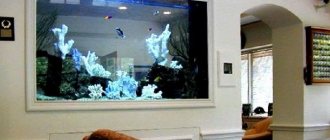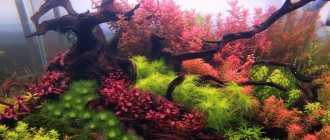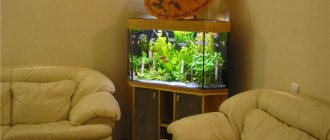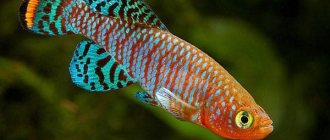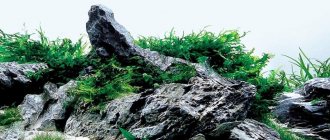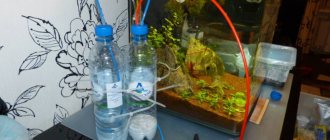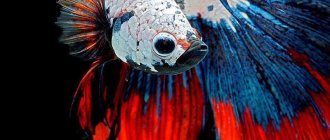Recently, the term “biotope aquarium” has become increasingly common among aquarists. Have you come across this mysterious phrase? In the article we will understand what a biotope in general and a biotope aquarium in particular.
Biotope aquarium
On a note ! The term “biotope” is of Greek origin (bios - life, and topos - place) and denotes habitats with certain living conditions, which include temperature, humidity level, type of substrate , illumination, etc.
What is a biotope aquarium?
So, a biotope aquarium is a natural ecosystem of some reservoir, created artificially with strict adherence to all its conditions, from chemical parameters to filling and appearance. Simply put, this is an exact copy of the water area, artificially created in the aquarium.
What is it like, a biotope aquarium?
Before creating a biotope aquarium, it is necessary to study the area of the reservoir in detail. And this, although painstaking, is no less interesting work. There are many streams, swamps, lakes, and rivers all over the planet. Each area, each depth segment, can have its own biotopes, very different from each other.
Note ! From the human perspective, a biotope aquarium, of course, should look harmonious and aesthetically pleasing. But the main rule is to collect as much information as possible about the area of the planet that you want to obtain.
A biotope aquarium is an artificially created aquatic ecosystem
It is worth remembering that some aquariums are only partially biotopes:
- species aquarium . Designed, as you might guess from the name, for a single species without reference to the area or to a specific biotope;
- ecological aquarium . Attached to living conditions, not to terrain. Designed to create a beautiful aquarium garden;
- geographical aquarium. Tied to a specific area. Designed to recreate the necessary conditions for fish located in the same geographical area.
Breeding Veiltails
Veiltails reproduce on their own, without any hormonal injections or without creating too specific conditions. In fact, good maintenance and proper feeding is a criterion and incentive for the spawning of spawners. All types of goldfish can spawn in small aquariums of 30 liters or more. However, better results can be achieved in larger aquariums or ponds.
From the editor: Lighting an aquarium with plants
You can learn more about the sexual differences of the veiltail and spawning from this article.
We recommend using Prodibio Aqua'Gold and Gold'Activ - a conditioner and biological culture developed specifically for cold-water fish. Why in ampoules, we wrote about this in more detail here, take a look.
Criteria for evaluating a biotope aquarium
To create a biotope aquarium, there are several evaluation criteria, according to which the habitat (biotope) and living organisms (biocenosis) can be ideally combined.
- Correspondence of biocenosis . Plants and inhabitants of the aquarium must correspond to a certain biotope, as in the environment.
- Biotope matching . The design elements of the aquarium (soil, driftwood, stones) and their combination should be the same as in nature.
- Placement of biocenosis . In a biotope aquarium, organisms should behave naturally, occupying proper niches. As for plants, they must accurately convey the natural appearance.
- Biotope quality . The composition and arrangement of the soil and decor must correspond to the natural needs of the fish.
- Location of biotope components . The soil and decor should create a natural relief that creates the effect of being in the underwater world.
- Quality factor of organisms . Organisms and plants should appear healthy, and their quantity should correspond to the volume of the aquarium.
Video - What are biotope aquariums?
Appearance of Echinodorus amazonicus
Externally, the young Amazonian Echinodorus is similar to its closest relatives - yarrow, small and dwarf Amazons.
Like tennelus, Amazon is a bush plant. The stem is short and almost invisible. Visually, it seems that many leaves are extending from the bunch of horses.
Amazon leaves are elongated in the shape of a sword with pointed ends. Old leaf blades closer to the surface of the water have wavy edges.
The length of the leaves together with the petioles can reach up to 45-50 cm. With sufficient lighting, the color of the plate is usually bright green, but may darken slightly. In the absence of sufficient nutrition, they acquire a brownish or reddish tint.
The root system is powerful. The roots penetrate deep into the soil of the aquarium. Therefore, when planting Echinodorus amazonicus, you should take care of the height of the substrate and nutrition.
TOP 5 biotopes common among aquarium enthusiasts
Let's look at what types of biotope aquariums are most common.
No. 1. Amazon
Amazon
Creating a biotope of the Amazon River is not as difficult as it might seem at first glance. First of all, the dark color of the water is due to humic acids and tannins. The acidity of the water is high (5-6.5 pH), hardness is in the range of 3-10 dGH, temperature is approximately 25-28°C. To make the water in the aquarium dark, natural ingredients with a high tannin content are used - peat , coconut fiber, oak, beech and almond leaves. The presence of driftwood is also important. It is worth knowing that not all plants will grow in such water; you can use various echinodorus, pinnately matogros, cabomba, limnobium, etc.
What fish is it suitable for : red neons, corydoras, tetras, dwarf cichlids, discus, panakas, angelfish.
No. 2. Lake Tanganyika
Lake Tanganyika
The water in this incredibly large and deep lake is quite hard (10-25 dGH), acidity is 7.5-9 pH, and the temperature ranges from 24-26°C. When creating a Tanganyika biotope in a home aquarium, it is necessary to respect the natural parameters of the water so that the fish can exist comfortably in it. When designing, special attention is paid to rocks and stones - they need to be placed so as to form a large number of crevices and shelters.
What fish is it suitable for : lamprologus, tropheus, altolamprologus, frontosa, julidochromis, mastacembelus, pinnate catfish.
No. 3. Rivers of Africa
Nun River Oxbow Aquarium in Bayelsa National Park in the Niger Delta, Nigeria
The water in African rivers is very different from the water in lakes on the continent. For example, consider the biotope of a section of the Congo River in Central Africa. So, the bottom is covered mainly with small stones and light sand. There are few plants (mostly anubias, crinums and ferns), but there are a lot of sunken driftwood. The water temperature is approximately 25°C, hardness is up to 20 dGH, acidity is 6-7.5 pH. When recreating such a biotope, light soil, small round stones, and branched snags are used. As for plants, these are Bolbitis, Anubias (excellently attached to snags), Crinums (wavy, aquatic), and nymphs.
What fish is it suitable for : tetras, elephant fish, distichodas, dwarf cichlids, synodontis, pantodons (butterfly fish). However, remember that not all of them get along with each other.
No. 4. Southeast Asia
Aquarium “Forest backwater of the Tambezi River in the province of Jamba, Sumatra”
In the reservoirs of this region there is a low content of mineral salts in the water, the temperature is 24-26 ° C, acidity is about 6 pH, hardness is in the range of 5-10 dGH. To create a biotope Asian aquarium, you need abundant vegetation combined with driftwood and open ground areas. It is advisable to place dark small stones at the bottom. An option that is as close to natural as possible is a terrace arrangement of decor. It is also worth noting the rich selection of plants (various cryptocorynes, aponogetons, rotals, hygrophiles, barclays, and ferns).
What fish is it suitable for : gourami, Indian catfish, barbs, acanthophthalmus, rasboras, badis, zebrafish, aplocheilis, loachfish, bettas.
No. 5. Rivers of the central zone of the Russian Federation
Rivers of the central zone of Russia
In most rivers of the central zone, the water is quite cold - about 16-18 ° C in the summer. The current is fast and there is abundant aquatic vegetation along the banks. The bottom is covered with stones, clay or sand, and you can often find sunken driftwood. The water is clear, with medium or high hardness (10-30 dGH). Acidity ranges from 6.5-7.5 pH.
Fish can grow to impressive sizes
To create a river biotope, you will need a spacious aquarium, since most fish can grow to impressive sizes. It is also important to take care of high-quality filtration and aeration . The bottom can be decorated with both boulders and small stones. Many river fish are predators, which, among other things, need to be provided with shelter in the aquarium (snags, crevices, grottoes, plants).
What fish is it suitable for : bream, catfish, pike, perch, etc.
The most creepy and dangerous inhabitants of the Amazon
Black caiman
The largest individuals of this alligator reach 6 m in length. They have the reaction of a mongoose and the strength of a tiger. The most dangerous predators of the Amazon, which will tear to shreds anyone who falls into their huge jaws.
Anaconda
Another huge predator that lives in local waters is the anaconda. This is the world's largest snake, weighing up to 250 kg. Anacondas reach 9 m in length and 30 cm in diameter. If such a snake wraps itself around a person, he will no longer be able to escape. These monsters love shallow water, so they spend most of their time in the tributaries of the river.
Arapaima
These giants have armored scales, so they don’t even care about piranhas. Arapaima hunt mainly for smaller fish and birds, but sometimes they also attack humans. Fish grow up to 3 m in length and weigh up to 90 kg. The monsters are so ferocious that they even have teeth on their tongues.
Brazilian otter
Even the otters here are gigantic. These 2-meter animals hunt fish and crabs. However, there is strength in numbers: when they gather in flocks, they kill adult anacondas and even caimans.
Vandellia vulgaris (Brazilian vampire)
These small parasitic fish look completely harmless. However, they are more dangerous than the largest predators. Usually the fish parasitize the gills of large fish, bleeding them with their spines, but they can also enter the human body. Then they cannot be removed without surgical intervention.
Bull sharks
Such cute little animals most often live in salty ocean water. Unfortunately, sometimes they swim into fresh waters and terrify local residents. Their jaws provide a bite force of 589 kg. After meeting with them, usually no one survives.
Electric eels
Two-meter eels can strike victims with a charge of up to 600 volts. And this is almost 3 times more than in the outlet. It seems like a killer tension, but it's not. It's not the discharge that kills. The victim simply stops breathing from the painful shock and drowns in the water.
Common Piranha
These little creatures often appear in Hollywood horror films. And it’s not without reason that they gained fame as ruthless killers. The sharp teeth of these fish close together and tear the flesh to shreds. It is noteworthy that piranhas are scavengers. But they do not disdain fresh meat.
Mackerel hydrolic
These underwater bloodsuckers have truly vampiric fangs located on the lower jaw of the hydrolics. The victim is impaled on them like a stake, and can no longer escape anywhere. Hydroliks have special holes in their palates to hide such long fangs.
Brown pacu
These fish with human smiles are relatives of the previously mentioned piranhas. Although pacu prefer fruits and nuts, there are also cases of attacks on people.
Master Class. A simple biotope aquarium for cardinals (Tanichthys albonubes)
The aquarium recreates the fast streams of the Baiyunshan Mountains. The base will be yellowish river sand, as well as smooth boulders and pebbles with pretty white veins. This project is ideal for beginners, since everything will take no more than 2 hours.
Step 1 . An aquarium of 60x30x30 cm with a volume of 54 liters is used, glass thickness is 6 mm. There are no ties or stiffeners in the aquarium, and therefore it is ideal for using an external lamp.
Step 2 . Soil is added - natural river quartz, which is inexpensive and looks very natural. There are no plants in the composition, so the thickness of the soil layer can be minimal. However, this should be enough for the support that will be needed when installing large boulders.
Step 3 . Several stones are arranged in the aquarium using the “golden ratio rule”. This way the finished composition will look more balanced and aesthetically pleasing.
Step 4 . The composition is complemented by smaller stones and pebbles, which are located around the main boulder.
Step 5 . The finishing touches will be very small stones. A few pebbles of 0.5-1.5 mm are added on top of the soil, but you should not completely cover the quartz. This will ensure a nice transition from the front of the aquarium to the back.
Step 6 . Water is poured through a colander so as not to destroy the entire composition and wash away the pebbles and sand. The water in the example is quite hard (GH – 14, KH – 7, pH – 7.5), but it is excellent for cardinals.
Step 7 . An upper canister filter with biological filler is installed, which will maintain crystal clear water. Alternatively, you can use a high-quality external filter .
Step 8 . Cardinals are placed in the aquarium. They are easy to care for - just feed them dry flakes or frozen food once a day, change ¼ of the water weekly and maintain the external filter every month.
How to fix moss, anubias, bucephalandra in an aquarium
Nitrates in the aquarium: how to reduce, check, fight and maintain
The smallest aquarium fish: types and care for them
TOP 20 most beautiful aquarium fish
TOP 12 most expensive aquarium fish
Aquarium fish that do not spawn, but give birth to fry
The water in the aquarium becomes cloudy: the reason, how to eliminate it
Heater for an aquarium. Temperature in the aquarium
Content Features
Aquarium predator fish require a large reservoir. Most carnivorous fish have an aggressive disposition and territorial behavior, so they should be kept in species-specific aquariums. Fish of similar size and temperament are suitable as neighbors for peace-loving species. The pond should be equipped with shelters and dim lighting should be created.
Feeding predators is carried out 2-3 times a day in small portions. Fish that swallow large prey whole are fed 3-5 times a week. Live fish, earthworms, mollusks, tubifex, bloodworms, brine shrimp, coretra and other invertebrates are used as feed. It is not advisable to feed mammalian meat, as it is poorly digested and leads to fish diseases.
Water parameters for most types of tropical fish are similar: temperature 22-30°C, pH 6.5-8, dH 8-20. The reservoir must be equipped with a powerful filter and aeration system. Residues of animal feed in water quickly decompose, releasing toxic substances. In this regard, it is necessary to clean the aquarium weekly with a siphon and replace 1/5-1/3 of the volume with fresh water.
